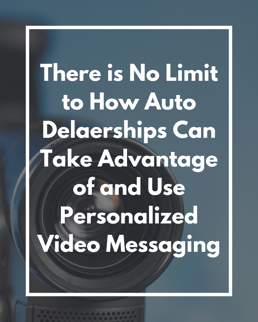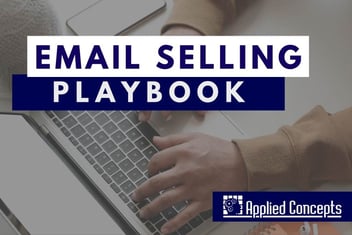D2C Video Messaging Playbook


Applied Concepts partnered with Covideo, a market leader in video messaging used by automotive dealerships worldwide to convert leads into customers, to develop this Video Messaging Playbook.
If a picture is worth a thousand words, then what is a video worth? Considering 75% of auto shoppers say video has influenced their purchases, videos can be worth quite a lot to an auto dealership.
Quick Links
- What is Video Messaging?
- The Psychology
- How Auto Dealerships Can Use Video Messaging
- Video Messaging vs. Other Types of Video Communication
- How Personalized Video Messaging Can Help a Dealership
- What Dealerships Get Wrong When Sending Personalized Video Messages
- Some Great Ways to Use Video Messaging
- Top Tips for Video Messaging Success
- Getting Started
- Aligning Video Messaging with Sales Training
- Final Thoughts
What is Video Messaging?
Video messaging is a modern approach to communication that allows you to record, edit, send and track personalized videos to prospects and customers via email, text or direct message on social media. Think of it as a video voicemail; the message doesn’t change, just the medium.
Video emails and texts are simple video messages recorded using a webcam or a smartphone and used in place of a typical text only message. The idea is to send a dynamic, hyper personalized message that gets noticed and responded to at a significantly higher rate than a plain text email. Video messaging lets customers put a face to a name and enables salespersons to build trust and stronger relationships.
Video messaging is NOT creating a single video to be viewed by many people on social media or a dealership website. Video messaging is one-on-one communication that is personalized and created for a specific individual.
The Psychology
Words only account for a fraction of human communication, while tone, inflection, gestures, facial expressions, eye contact and so on make up the bulk. Seeing another person and hearing their voice fires up neurons that help people recognize faces and understand their expressions. This emotional information is absorbed, and we respond by making micro decisions about whether we like and trust that person. This emotional contagion shouldn't be underestimated. If a salesperson wants to get a customer excited about a new vehicle, for example, they are much better off conveying that excitement through video than text. In addition, body language and facial expressions help with information retention.
How Auto Dealerships Can Use Video Messaging
While there is no limit to how an auto dealership can use video messaging, there are four primary ways it is generally used:

- Sales: Incorporating video into the outreach process encourages customer engagement, builds trust and differentiates a dealership from its competition. This can increase contact ratio and gets more buyers into the dealership.
- Business Development: A strong automotive lead response is a dealership’s first opportunity to reconnect with a buyer who visited its site. This gives the salesperson the chance to leave a lasting impression, stand out from the competition and build a positive customer experience.
- Service: Build transparency and create a positive customer experience by using video to highlight the current condition of a customer’s vehicle. Providing superior service maintains customers and generates referrals.
- Auto-Responders: Buyers are three times more likely to visit a dealership if a salesperson responds within 10-30 minutes. Convert online leads into showroom traffic by sending automatic, personalized videos through a CRM whether in or out of the office.
Video Messaging Versus Other Types of Video Communication
It’s important to understand that personalized video messaging differs from other forms of video communication.
 Marketing Videos
Marketing Videos
- Polished, professional, highly editing.
- Large investment of time and money.
- Used for advertising, websites or email campaigns.
 Social Media Videos
Social Media Videos
- Fun, inexpensive, more casual.
- Distribution channels are limited (can only be seen by people who follow dealership account).
- Content is meant to be consumed in mass.
 Video Conferencing
Video Conferencing
- Great for live, two-way conversations.
- Both parties agreeing to meet on a specific day/time.
- Synchronous communication; scheduled, real-time interaction.
 Video Messaging
Video Messaging
- Delivered via email, text or social media DM.
- One-on-one communication.
- Authentic, stripped-down.
- Hyper-personalized to the individual customer and their situation.
- Asynchronous communication; happens on each person’s own time and doesn't need scheduling.
How Personalized Video Messaging Can Help a Dealership
Despite the many – and often expensive – digital sales tools dealerships use to increase lead volume, it is often a struggle to mirror that increase in contact ratio and appointment set-to-show ratio. Why is this? In the current cultural climate, buyers love the comfort and ease of being able to shop from their homes or offices using their computers and mobile devices. Because of this, dealers are seeing more than 70% of their leads coming from the internet. The conundrum here is that while people enjoy shopping online, they still want to do business person-to-person, rather than device-to-device.
Enter personalized video messaging.
Only 20% of customers will read through a plain text email, while 80% will watch a video. When a dealership incorporates video into its digital sales process, several key things are being accomplished that will increase contact ratio and drive more buyers into the dealership.
- Differentiate from the competition. Good salespeople are a dealership’s greatest asset and biggest differentiator, so it only makes sense to put them front and center, instead of hiding in an already-overcrowded inbox. A video message immediately differentiates a dealership from its competition and makes the message more memorable. 95% of a message is recalled when delivered via video, versus just 10% with text.
- Increase customer engagement. Video increases engagement by 60% compared to plain text communication. This is because buyers prefer video over text, so when drab, wordy emails and texts are transformed into personalized videos, it creates more meaningful experiences that spark more conversations and build stronger connections.
- Build trust and rapport. By using video instead of just plain text to communicate with prospects and customers, a dealership can build trust and rapport more rapidly by connecting a face and voice with a name. A video also offers the advantage of tone, inflection, eye contact and body language, all important elements of communication that are lacking in text communication. Building rapport with buyers in the digital world increases the likelihood they will engage in the real world and opt to visit the dealership in-person.
What Dealerships Get Wrong When Sending Personalized Video Messages
Creating video messaging for customers is not difficult, however there are three mistakes that are commonly made by dealerships:
- Recording and re-recording videos to get the perfect take. Personalized video messages aren’t meant to be sleek and sexy marketing videos. They should be authentic, real and off-the-cuff. This makes the videos more relatable and approachable so the recipient can get a genuine sense of the salesperson and the dealership. Trying to get a perfect take usually results in the recording sounding scripted and robotic instead of honest and transparent. Trying to get the perfect take also eats up valuable time, causes frustration and can discourage salespeople from continuing to use video in their process.
- Not making it personalized. Some salespeople will be tempted to take a shortcut and just use one canned video over and over, instead of making it personalized for a specific customer. This approach completely defeats the entire purpose and power of video messaging. For those salespersons who have a ton of messages to churn out, it is possible to use a canned video as part of the message for situations that come up frequently, but it should be combined with a personalized introduction where the recipient's name or references to their unique situation are used.
- Inconsistency. Like any good habit, sending personalized videos should be done consistently as part of a larger outreach strategy. Sending one video and giving up isn’t going to cut it. Video should be a daily practice, which will help a dealership’s sales force improve its skills and yield positive results.
Some Great Ways to Use Video Messaging
Internet Lead First Response: Respond to leads with a video introduction to make a great first impression and present next steps.
Vehicle Walkaround: Offer customers a 360-degree video of the exact vehicle they’ve inquired about, highlighting special features, color and condition and showcase additional inventory on the lot.
Appointment Reminders and Details: Send video reminders for upcoming appointments to help increase show rate and provide necessary details. Make the customer feel the dealership is anticipating and preparing for their arrival with a personalized experience.
Customer Thank You's: Finish strong by sending buyers a personalized thank you message after a deal is complete and create an opportunity to ask for reviews and referrals.
Top Tips for Video Messaging Success
- Don’t send videos as attachments. Videos are generally large files that will generally be looked upon as suspicious or will be flagged and sent straight to the spam folder. Instead, use a video messaging platform or host the video and include a link in the email.
- Include a clickable video thumbnail or animated GIF.
 Consumers are rightly wary of clicking on raw URLs and unknown links in emails. Instead include a clickable thumbnail or animated GIF from the video and hyperlink it to where the video is hosted. This identifies the video for the recipient and makes for a more engaging email.
Consumers are rightly wary of clicking on raw URLs and unknown links in emails. Instead include a clickable thumbnail or animated GIF from the video and hyperlink it to where the video is hosted. This identifies the video for the recipient and makes for a more engaging email. - Add the word “video” to your subject line. Including the word “video” in the email subject line can help increase open rate by 19%. The subject line can even be personalized, such as “{Dealership name} video for {Customer name}.”
- Look at the camera when recording. When recording videos, the salesperson should fix their eyes on the camera of the computer or mobile device. This creates direct eye contact with the customer.
- Work with the basics. Use the built-in webcams on a laptop or mobile device. Leave the fancy equipment and hefty budgets for marketing videos. Apps like Covideo make it extra easy to record and send high quality videos.
- Capture all necessary content in the frame. If the video includes a vehicle, make sure to film in landscape for a wider angle. If it is just a salesperson talking, portrait mode is a great option.
- Don’t forget to smile. Smiling makes a person appear friendly, trustworthy and approachable, and it also helps the speaker set the right tone in their voice.
- Add lots of personalization. The message should be specific and relevant to the individual it is being sent. The customer should be referenced by their name, their unique situation or questions should be referenced and a whiteboard with their name can even be held so it shows up in the video thumbnail.
- Ditch the script. Reading word-for-word sounds rehearsed and impersonal. Instead, try delivering messages off-the-cuff so it’s authentic and conversational.
- Power through mistakes. Trying to get a perfect take will lead to lots of frustration and wasted time. Little imperfections show a person is human and relatable.
- Include calls-to-action. Include clear next steps at the end of the video to encourage actions.
- Maintain engagement. Discuss noteworthy information in a relevant amount of time. Aim to keep video vehicle walkarounds to less than two minutes and non-walk around videos to less than one minute.
Getting Started
Getting started with video messaging is relatively simple. A dealership can work with a provider such as Covideo, or venture out on their own with a few basic tools:
- A way to record. A mobile device or webcam built into a desktop or laptop will work just fine. Don’t have a webcam? It is relatively inexpensive to buy an external webcam that will work with any computer.
- A place to host and store videos. Platforms such as YouTube or Vimeo work, however the easiest and fastest way is to use a video messaging tool that automatically saves, uploads, encodes and hosts videos.
- A way to send. It’s essential to host videos to share them with a link instead of trying to send the video file. Once a link is generated, there are any number of platforms that can be used to send it via email, CRM software, text or social media DM.
- A way to track. Using the do-it-yourself approach, tracking can be a bit of a guessing game. Most video hosting platforms show how many times a video has been viewed, however won’t be able to see who watched it, when they watched it or for how long. Tracking for engagement and ROI is important, so at some point a video messaging tool should be considered.
Aligning Video Messaging with Sales Training
Dealerships can maximize their video messaging results by incorporating the process in sales training efforts. When implementing a video strategy, it is important to create a formalized process; the best way to ensure sustained success is to develop a plan, write it down and set expectations for usage and implementation. For example, one protocol may be that when a new internet lead comes in, the customer is called within five minutes and then a personalized video is the FQR. This ensures video is being used in the right way, at the right time and delivers a consistent experience for all prospects and customers.
The goal of video messaging is providing a quality interaction with customers, and many of the same principles taught for in-person, phone and email/text communications can be applied when using video communication. With video messaging having the ability to inject both voice inflections as well as body language, training becomes even more crucial for techniques that are unique to video. Those that take this seriously and train accordingly are more likely to properly execute their video strategy while ensuring they provide quality interactions that result in high customer engagement.
Final Thoughts
Video in general has become one of the most powerful tools for marketing and selling vehicles. 40% of auto shoppers said video helped them discover a vehicle they weren’t aware of or considering, 59% of consumers prefer watching a video about a product over text, the watch time of test drive videos on YouTube has grown by more than 65% during the past two years and 72% of customers prefer video to reading text when researching their next vehicle purchase.
Combining the power of video with the effectiveness of personalization is an unbeatable approach that has the potential to significantly impact a dealership’s ability to reach customers in meaningful ways that will increase both long- and short-term revenues.
For more information and examples of video messaging, check out the Covideo YouTube channel.



